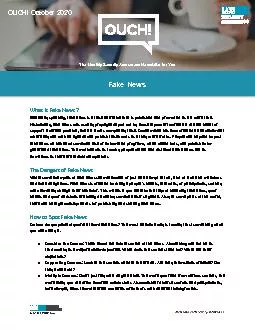

Fake News The Monthly Security Awareness Newsletter for You OUCH October 2020 Check the Author Who is the author Research them to see if they are a credible author their reputation in the communit ID: 826784
Download Pdf The PPT/PDF document "What is Fake News?" is the property of its rightful owner. Permission is granted to download and print the materials on this web site for personal, non-commercial use only, and to display it on your personal computer provided you do not modify the materials and that you retain all copyright notices contained in the materials. By downloading content from our website, you accept the terms of this agreement.
What is Fake News?Fake News The Month
What is Fake News?Fake News The Monthly Security Awareness Newsletter for You OUCH! October 2020 Check the Author: Who is the author? Research them to see if they are a credible author, their reputation in the community, whether they have a specific agenda, or if the person posting is a real person. Are they authoring within their field of expertise?Check the Date: Make sure that the date is recent and that it is not an older story simply rehashed.Comments: Even if the article, video, or post is legitimate, be careful of comments posted in response. Quite often links or comments posted in response can be autogenerated by bots or by people hired to put out bad, confusing, or false information.Check Your Biases: Be objective. Could your own biases influence your response to the article? A problem that we humans often run into is that we only read sources that simply confirm what we already believe in. Challenge yourself by reading other sources you normally would not review. Check the Funding:Even legitimate publications have sponsors and advertisers who can influence an article or source. Check to see if the article is funded, and if so by whom.Repost carefully: Fake news relies on believers to repost, retweet, or otherwise forward false inform
ation. If you’re uncertain as to th
ation. If you’re uncertain as to the authenticity of an article, think twice or hold off on sharing it with others.ConclusionIn today's fastpaced world of social media, fake news surrounds us every day. If you are not careful, you run the risk of believing and acting upon it. Take the time to follow these basic steps to help ensure you make informed decisions based on facts.Guest EditorJason Jordaan is the Principal Forensic Analyst at DFIRLABS, a digital forensics specialist, and an incident response service provider. He is a SANS Certified Instructor who teaches Windows Forensicsand Advanced Incident Response, as well as a coauthor for the new Digital Forensic Essentialscourse. Follow him on Twitter at @DFS_JasonJ. ResourcesPoster: How to Spot Fake News http://blogs.ifla.org/lpa/files/2017/01/HowSpotFake-News-1.jpg Social Engineering: https://www.sans.org/security-awareness-training/ouchnewsletter/2017/socialengineering Translated for the Community by: OUCH! Is published by SANS Security Awareness and is distributed under the Creative Commons BYNCND 4.0 license. You are free to share or distribute this newsletter as long as you donot sell or modify it. Editorial Board: Walter Scrivens, Phil Hoffman, Alan Waggoner, Cheryl Conle